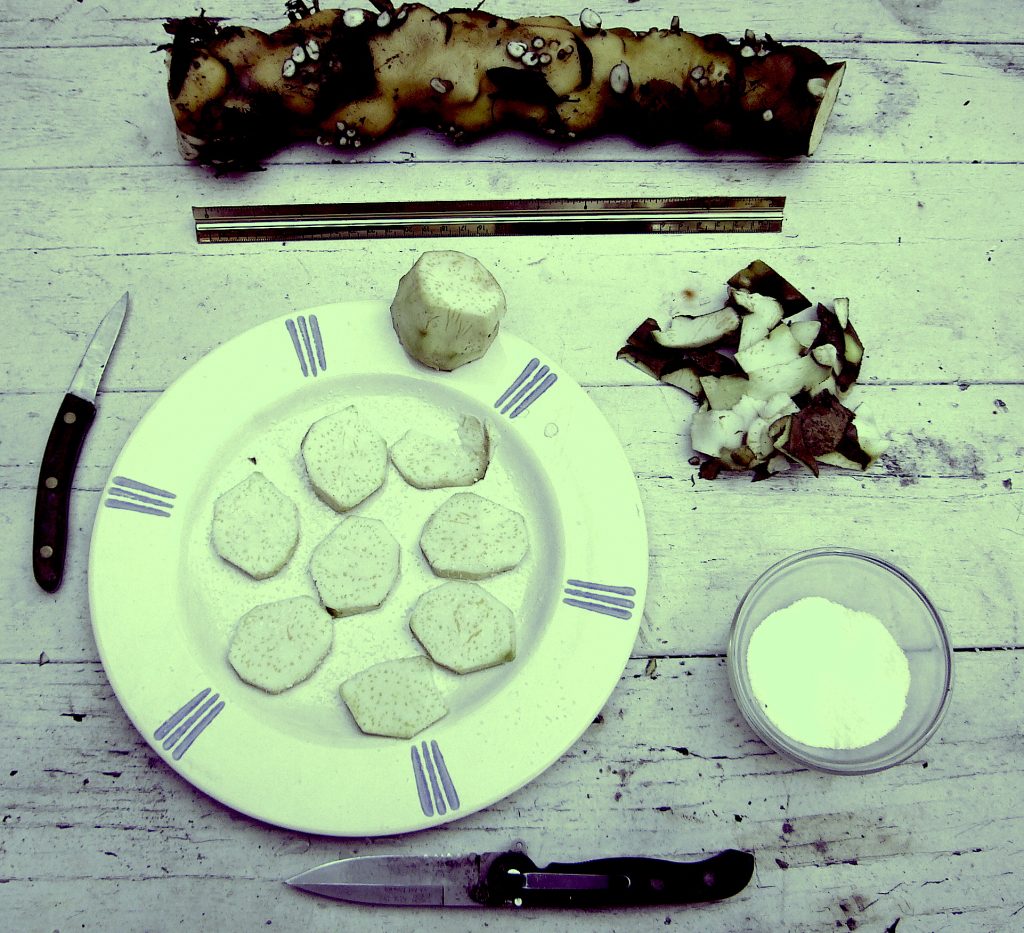
Salting Nuphar advena/arvenis root It didn’t help. Photo by Green Deane
Time for plan B… Well, actually it’s somewhere around Plan E or F. Above you see a root of the Nuphar avenis the yellow pond lily. If you’ve ever taken one of my foraging classes you have heard me rant about this plant and foraging books. All the books that mention the root say it is edible. I’ve never been about to make it palatable despite years of trying. It’s extremely bitter which had led me to believe writers who say it is edible have never tired it. I know two writers who excluded it from their books because they had the same experience as me. It might be time to reassess the root.
First the historical perspective: Nowhere else on earth was a plant in this genus reported as edible except in North America. But that is a fuzzy fact for three reasons. The first is there were clearly different species. Botanists were in denial of that reality for centuries. The second is we have one centuries-old report that the natives ate the root after “long boiling” and that it tasted like sheep’s liver. Sheep’s liver would be a fantastic improvement over what it tastes like naturally. So, we aren’t quite sure which Nuphar root the native were cooking up nor beyond boiling what they might have done to it. However some seeds are edible with processing. Add the fact that what was once a bunch of “variations” within one species is now many separate species with here-today gone-tomorrow scientific names. It is possible there was a Nuphar luteola/lutea in Maine that was same in name in Florida and Oregon but was a different species and edible. That’s iffy because no matter what you call the plant — in North America or Europe — no one actually seems to eat the root though one can find it everywhere… assuming the “it” is the same species. It is one of the most common uncommonly eaten edibles.
Starting in 2002 and up until I moved 13 years later I grew N. arvenis (what it is called today) in my backyard in a water-controlled pond. I got the starter plant from the Wekiva River. It had a wholesome life and was not sitting in tannic water all the time. As I say in my classes I tried everything I could think of over the years to make the root edible. I diced and soaked it for a week, changing the water as one does with acorns to reduce the acid load. I did the same for a month, changing the water daily. I simmered it for a week. Yes, a full week. I salted it. I dried it. I fried it. I baked it in the sun ending up with tough, bitter styrofoam-like lavender-colored plugs. Nothing worked which is a bit frustrating because it has the feel of eggplant and is easy to work with. The root looks like it should be edible. As I have said in my classes for many years I tried everything but fermenting the root. Don’t persume it is edible because a site or book says so.
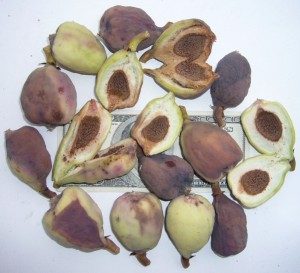
Creeping fig fruit. Photo by Green Deane
Many years ago I was coaxed into getting a beer at a small eatery in Tampa’s Ybor City. The beer was not memorable but the brick wall on one side of the outdoor patio was. It had a vine I had never noticed. It took awhile but I identified it as a Creeping Fig (and many other names.) It is also something of a chameleon: The young vine on first glance does not look much like the old vine so one can indeed find it and not know you have found it. Also given the right support — such as a strong fence — the vine can cover the entire fence to the extent the vine looks like a long line of shrubs. But then it produces green fig-like fruit. Only the sap of them makes it barely into the edible realm. To read more about the Creeping Fig go here.
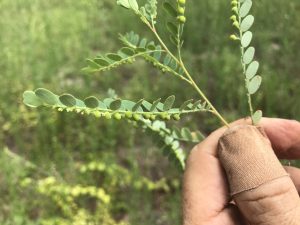
The blossoms and sees line up under the stem, photo by Green Deane
Chamberbitters, Phyllanthus urinaria, is medicinal not edible. We don’t cover herbals here because I am not qualified to talk about them much. However I know this one has a lot of good reserch behind it. This plant is a rich source of lignans, tannins, flavonoids, phenolics, terpenoids, and other secondary metabolites. Pharmacological activities include anticancer, hepatoprotective, antidiabetic, antimicrobial, and cardioprotective effects. As a point of identification note the seeds line up on the bottom of the stem. You can read about it here.
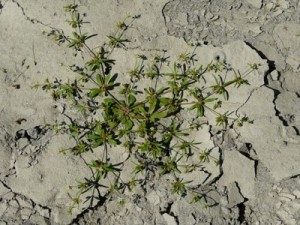
Carpetweed in Jacksonville, photo by Green Deane
One of the more common edible weeds underfoot in North America is Carpetweed, Mollugo verticillata. Scraggly if not scrawny the wispy plant does have the saving grace that it is all edible, raw or cooked and it requires very little cooking. Add it last. There are several non-edible species that can resemble it so there are some of key points to remember. First, it does not have any white sap, it grows in a circular mat, and the blossoms have five white sepals but usually only three stamens, sometimes four or five but usually three, which is a bit odd for a five-sepal plant. Look for it in dry, sandy locations including waste ground. For all of its wide-spread presence in North America it is actually native to the tropical Americas. You can read about Carpetweed here.
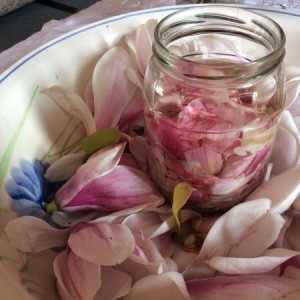
Magnolia blossoms in vinegar
Forty-seven years ago I was a foreign exchange student attending Whiteland College which was part of the University of London. I remember well four things about my time there. One was that they use Magnolia blossoms as a condiment. I thought that strange at the time. It’s a very intense flavor. You can make it yourself by dicing then lacto-fermenting the blossoms for a few days, draining, then storing it in the frig adding a little white wine and sugar helps. You can do the same thing with Nasturtium seeds. They smell horribly for three days but they taste great once drained and stored. You can also flavor vinegar with the white blossom petals (not as good I think.)
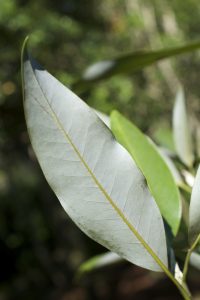
Magnolia virginiana leaves are easy to identify.
Magnolia grandiflora leaves can be used like a bay leaf, but have a bitter note. A close relative, the “Sweet Bay,” Magnolia virginiana, has been used that way for at least centuries and is highly esteemed for that use. The “Sweet Bay” a very common tree in damp areas and easy to identify. You can read about the Magnolias here. And what were the other three memorable items from the exchange? All the hallways in the college — which is now an upscale condominium — were named after local streets. So you didn’t live in room 213. It was 213 Wadsworth Way. The college had a ratio of ten to one women to men and its patron saint was St. Ursula, the saint of virgins which might explain why the college no longer exists. And right across the hedgerow was a hospital with the most awful name on a huge wrought iron banner over the drive way. It was: The Royal Hospital for the Incurably Ill.

Foraging Classes are held rain or shine or cold.
Foraging classes: I spent most of the month of June moving from the Orlando area to the Tampa area so I won’t resume two classes per weekend until the second week of July. And of course, for a few days at the end of June my internet service won’t exit, so responses will be late.
Saturday, July 2nd Red Bug Slough Preserve, 5200 Beneva Road, Sarasota, FL, 34233. 9 a.m. to noon
For more information, to pre-pay or sign up go here
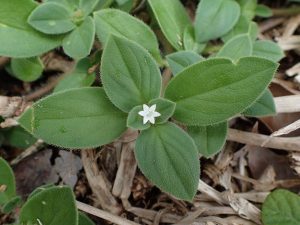
Richardia scabra is mistaken for Chickweed.
If a plant does not cause acute illness then judging when it might make you ill is difficult to say. It might take months of consumption (or perhaps with something like canned fiddlehead ferns, years.) One of those possible plants is Florida Pursley, aka Richardia scabra. I do know of a couple people who ate a leaf and had no problem. They mistook it for chickweed. I know of someone who ate several leaves at once and had gastrointestinal distress. And the roots are reportedly an emetic. More telling is that we have little information about how if at all it was used by Native Americans. That often is a clue it’s a plant to avoid, at least from a food point of view. If a plant is not in the ethnobotanical literature either the natives didn’t use it, we didn’t ask, or they didn’t tell us. It is best to stick we plants that we know for certain were used for food.
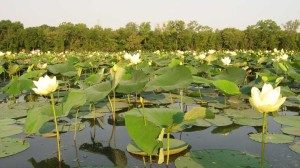
Yellow American Lotus, photo by Green Deane
Yellow ponds, that’s how I think of it, or in some places, yellow rivers. That’s because the American Lotus is in blossom. The first time I saw a small lake of these blossoms was when an old dry lakebed was deepened for a housing development. The next spring suddenly what was for decades a dry lake was full of American Lotus blossoms. This is because the seeds can stay viable some 400 years, or so the experts report. Talk about a survival food! There are multiple edible parts on the American Lotus but I prefer the seeds. I also think when collecting by hand the seeds provided the most calories for the least amount of work. The roots are edible but digging them up can be a messy, laborious job. Locally American Lotus are easy to find: Just look for a lake with large yellow blossoms on long stems. Further north and west they are a favorite sight on rivers such as the Mississippi. To read more about the American Lotus go here.

You get the USB, not the key.
My nine-DVD set of 135 videos has been phased out and replaced by 171-videos on a 128-GB USB, see left. The USB videos are the same videos I have on You Tube. Some people like to have their own copy especially if social order falters. The USB videos have to be copied to your computer to play. If you want to order the USB go to the DVD/USB order button on the top right of this page or click here. That will take you to an order form. Or you can make a $99 donation, which tells me it is for the USB (include a snail-mail address.) I’d like to thank all of you who ordered the DVD set over the years which required me to burn over 5,000 DVDs individually. I had to stop making them as few programs now will read the ISO files to copy them. Burning a set also took about three hours.

Green Deane Forum
Want to identify a plant? Perhaps you’re looking for a foraging reference? You might have a UFO, an Unidentified Flowering Object, you want identified. On the Green Deane Forum we — including Green Deane and others from around the world — chat about foraging all year. And it’s not just about warm-weather plants or just North American flora. Many nations share common weeds so there’s a lot to talk about. There’s also more than weeds. The reference section has information for foraging around the world. There are also articles on food preservation, and forgotten skills from making bows to fermenting food. Recent topics include: Fermenting potatoeswith yogurt, make a water filter, nixtamalization at home, Stale Bread and Cod Liver Oil, Life’s a Grind, Killing Bugs with Tobacco Plugs, Eating weeds: Is it safe? Have they mutated? Not the Eastern Red Bug but the Pink Tabebuia, African Tulip Tree, Asparagus densiflorus, Green Deane’s Book… You can join the forum by clicking on the button on the upper right hand side of this page.
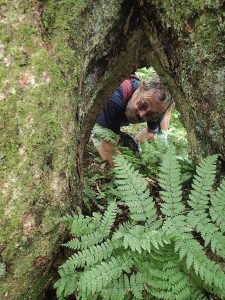
Eattheweeds, phto by Kelly Fagan
Unfinished businesss: My book Eat The Weeds is scheduled to be published the 12th of May 2023. Let’s hope there is still paper available then. National in scope it will have 296 species, color photos, 284,000 words and 753 pages (they cut out 75 species.) It will soon be available to pre-order.
This is my weekly newsletter #513. If you want to subscribe to this free newsletter you can find the sign-up form in the menu at the top of the page. My website, EatTheWeeds.com, which is data secure, has over 1500 plants on it in some 428 articles. I wrote every one myself, no cut and paste.
To donate to the Green Deane Newsletter click here.

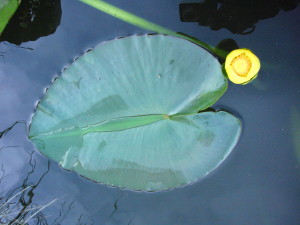
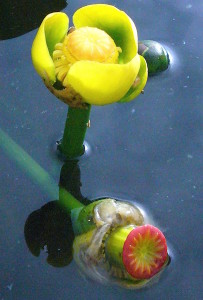

I want to buy your book ‘ Eat the Weeds’.
There will be a pre-order from in the newsletter. It goes on sale in May 2023.